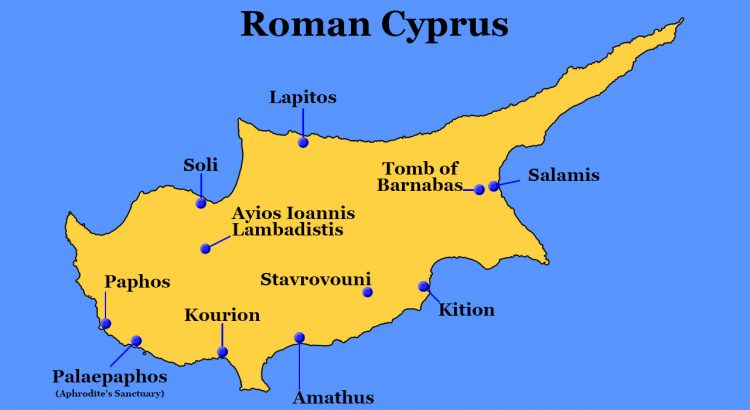The ancient city kingdoms of Cyprus were so well established by 673BC that they were listed on an inscription in Assyria in order to pay tribute to King Esarhaddon. Today many of those same cities are thriving communities, such as Paphos, Kition (Larnaca), Ledrai (Nicosia), and Kyrenia. Others are nothing more than the sleepy villages of Lapithos, Tamassos, Chytroi (Kythrea), and Idalion (Dali). The remaining once powerful kingdoms of Kourion, Salamis, Amathus and Marion are in ruins excavated by inspired archeologists and visited by curious tourists.
Kition’s ancient Temple District, with modern-day Larnaca as a backdropAncient Kition hardly exists today; Larnaca has built almost completely over it.
Kourion, Salamis, and Paphos played key roles in the Early Christian History of Cyprus, and because they are in ruins, they are easily toured and photographed. Kition, too, had a role, for it was the destination of Lazaras when he left Bethany. There is only a small unassuming piece of Kition left, however, for the modern town, Larnaca, has built over the ancient city in its entirety. At present, the tomb of St. Lazarus is all that remains of 1st century Christianity in the town according to the director of the District Museum.
Column at Kourion’s Basilica, with the coastal cliffs and Mediterranean Sea as backdrop
From the Kourion Basilica
The ancient city of Kourion has been been part of the great Phoenician, Hellenistic, Ptolemaic, and Roman Empires. Though, all left their mark on the city, today the ruins are almost completely from the Roman Period.
After 313AD, Christians lived in the city, but thus far the only early evidence of them at Kourion was a small bronze Chi-Rho ring found in the ruins of the earthquake of 365AD.
St Paul’s Pillar at Paphos with St Paul’s Church in the background
Paphos Basilica adjacent to ancient
Jewish synagogue and Paul’s Pillar
Paphos, also known as Nea Paphos, was the set of the Roman government on Cyprus. In the first century AD Barnabas and Paul went to the proconsul’s chamber where Paul performed his first miracle.
According to Jerome, in the 4th century, St. Hilarion came to the town to preach and proselytize, and by the early 5th century a magnificent basilica was built.
Columns at the Salamis bath complex viewed across a field of yellow spring flowers
Ancient Salamis
The ancient city of Salamis had been a major port of the eastern Mediterranean Sea from the time of the Phoenicians, and became a major port of the Roman Empire. It was considered the ‘cultural’ city during the Roman Period, while Paphos was the ‘civil’ center.
Barnabas and Paul arrived at Salamis on their First Missionary Journey, and Barnabas was martyred there and buried only a mile from the city.
